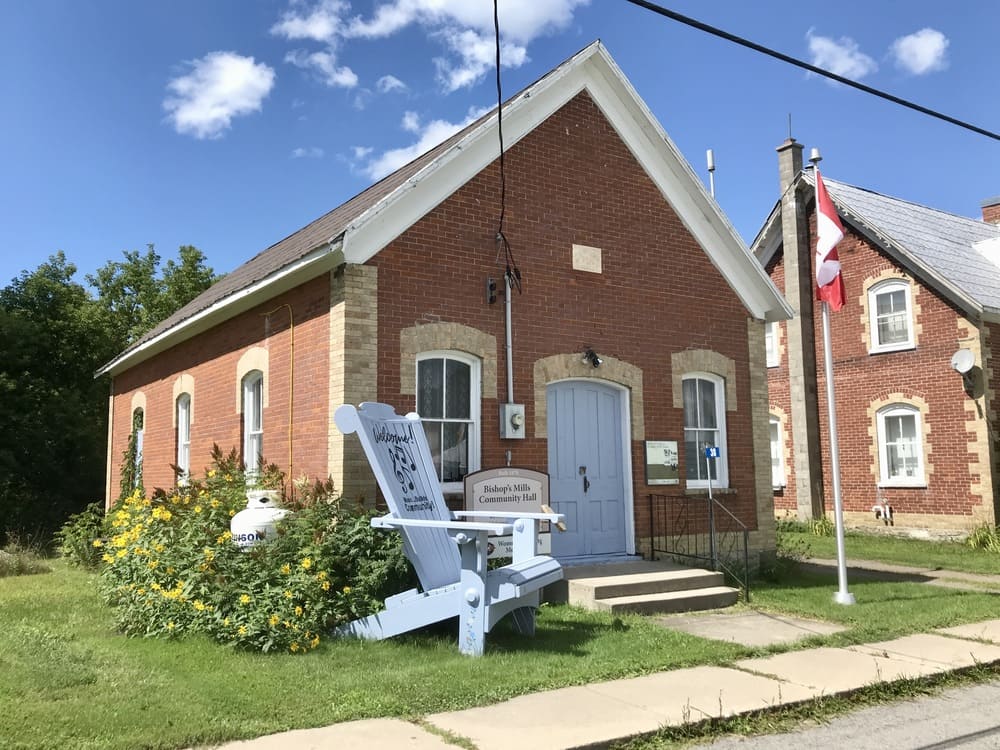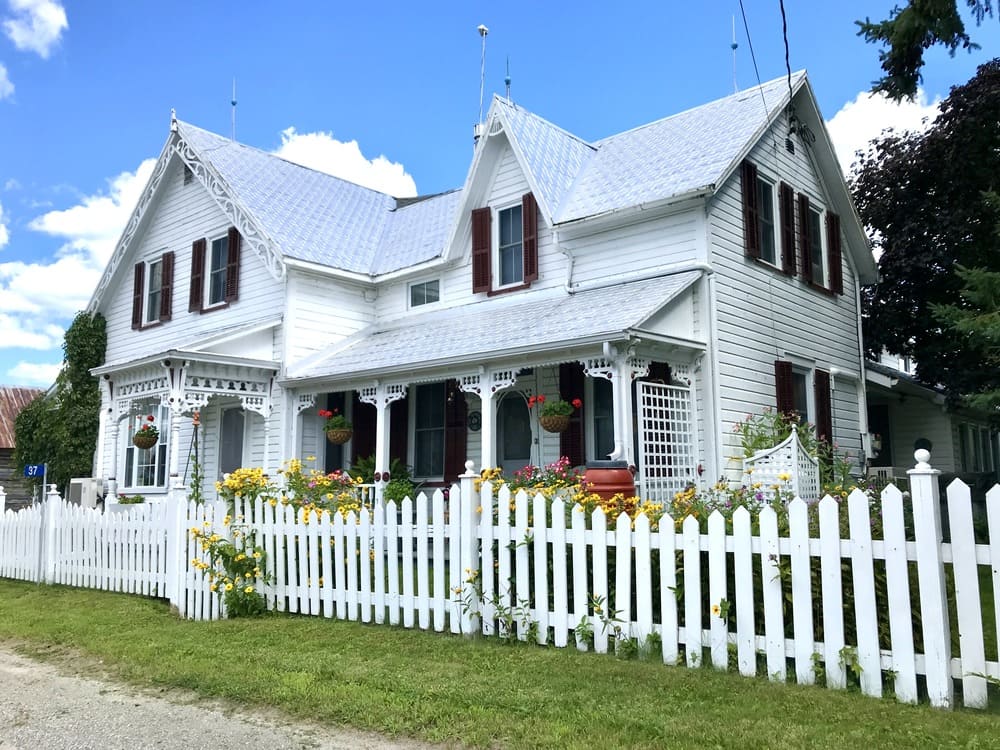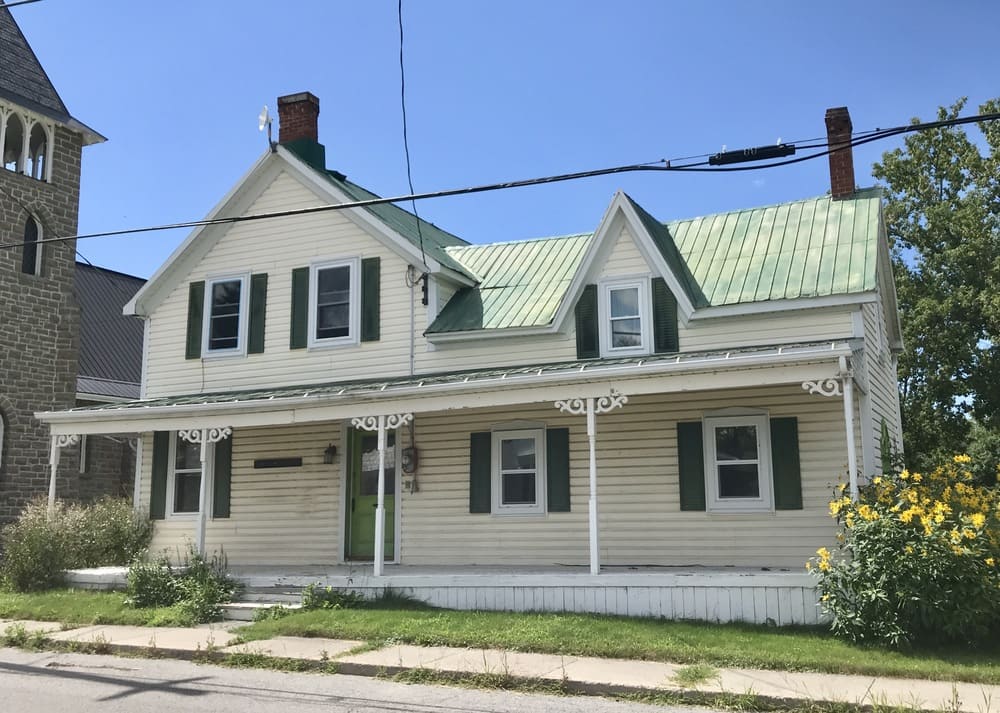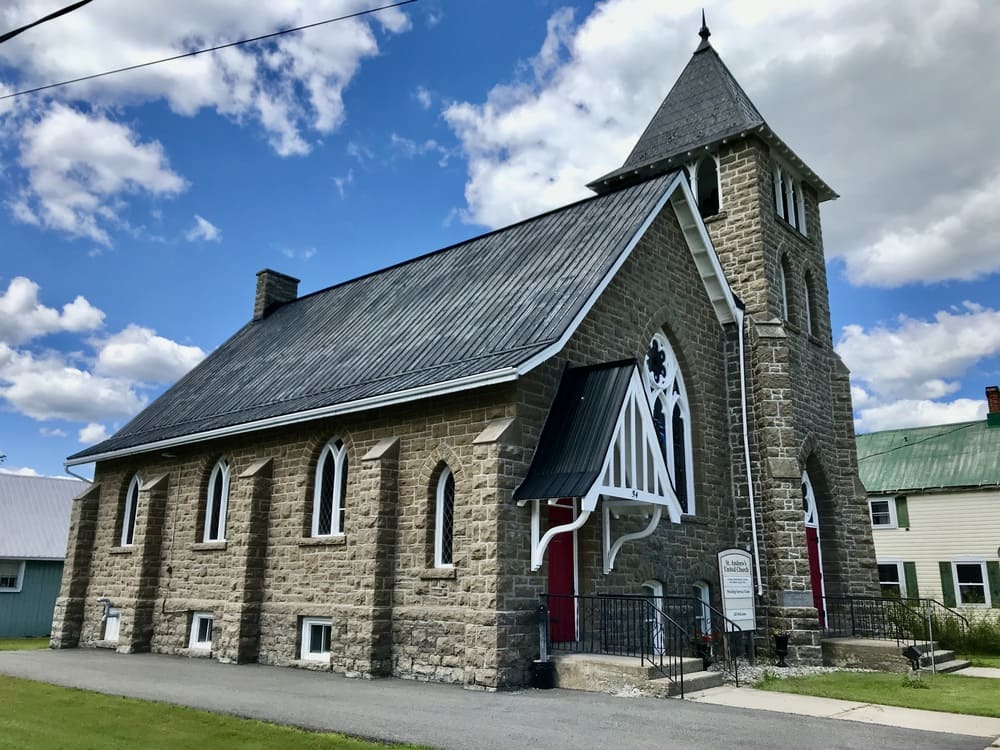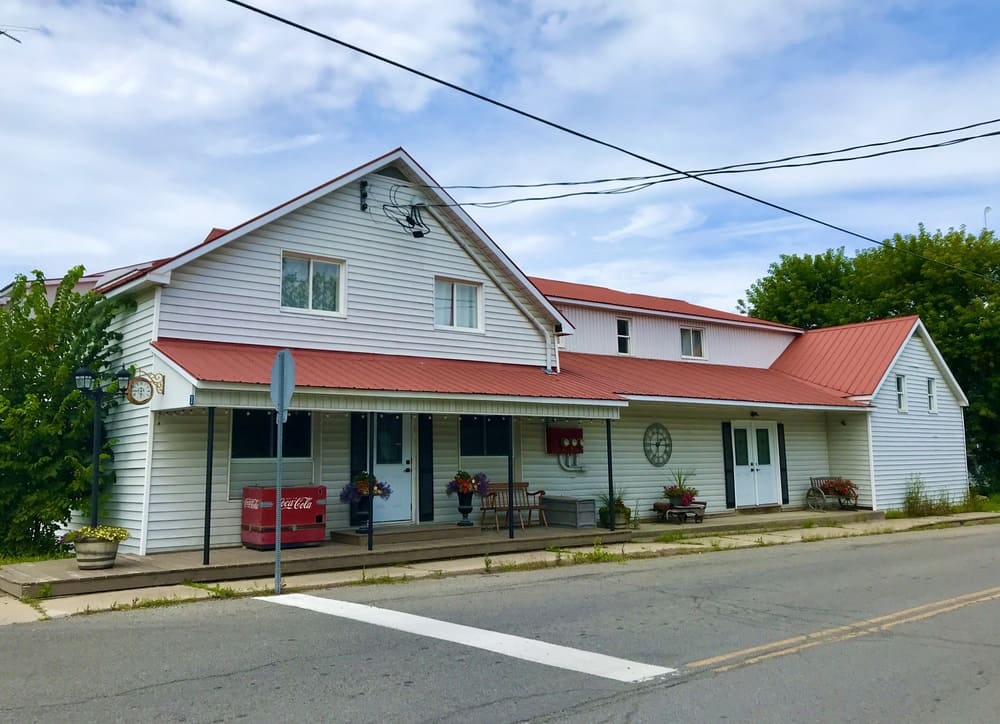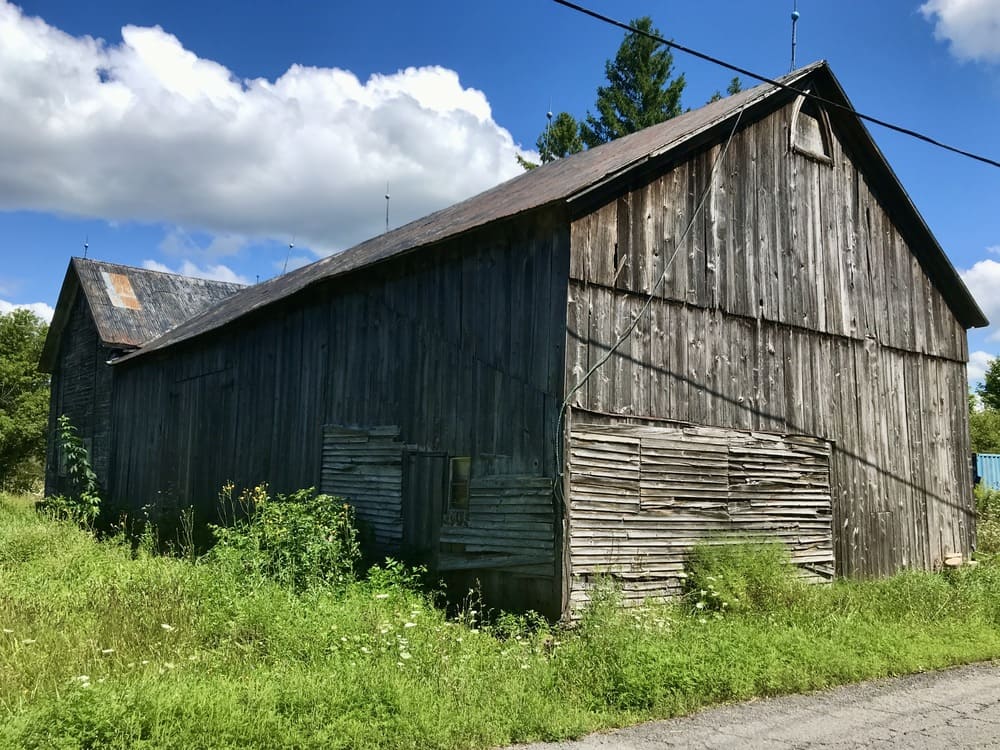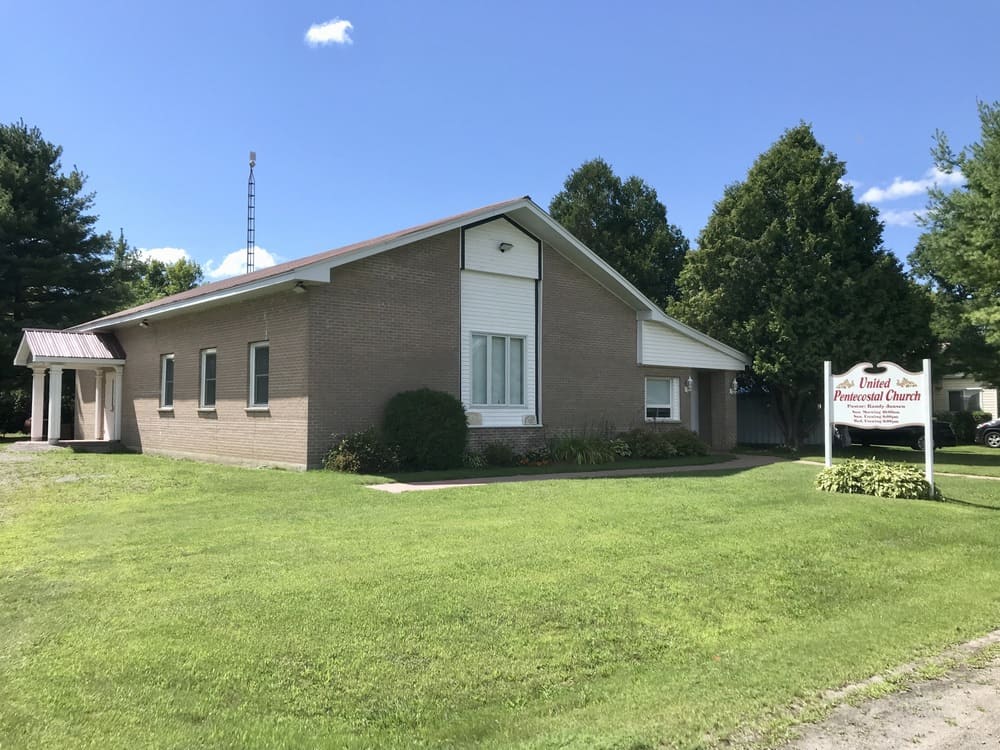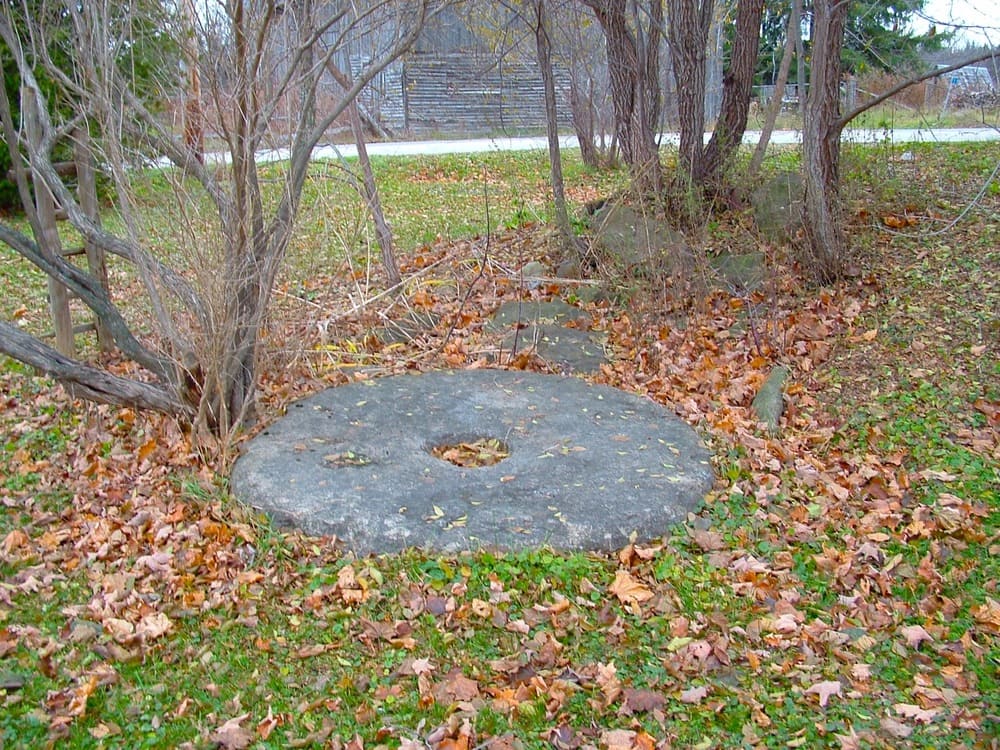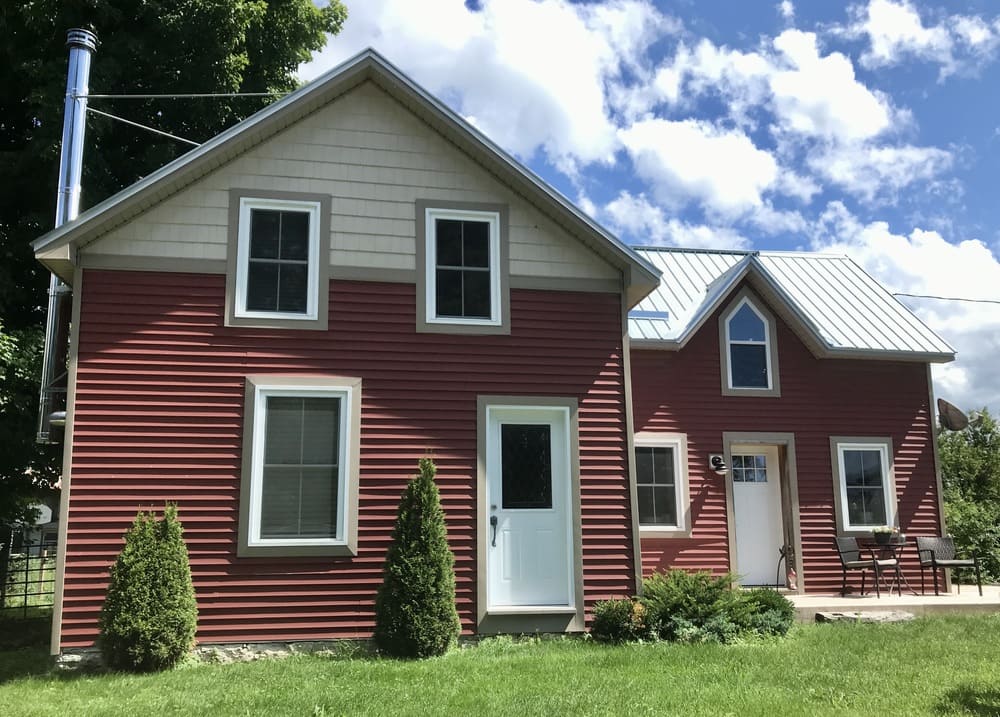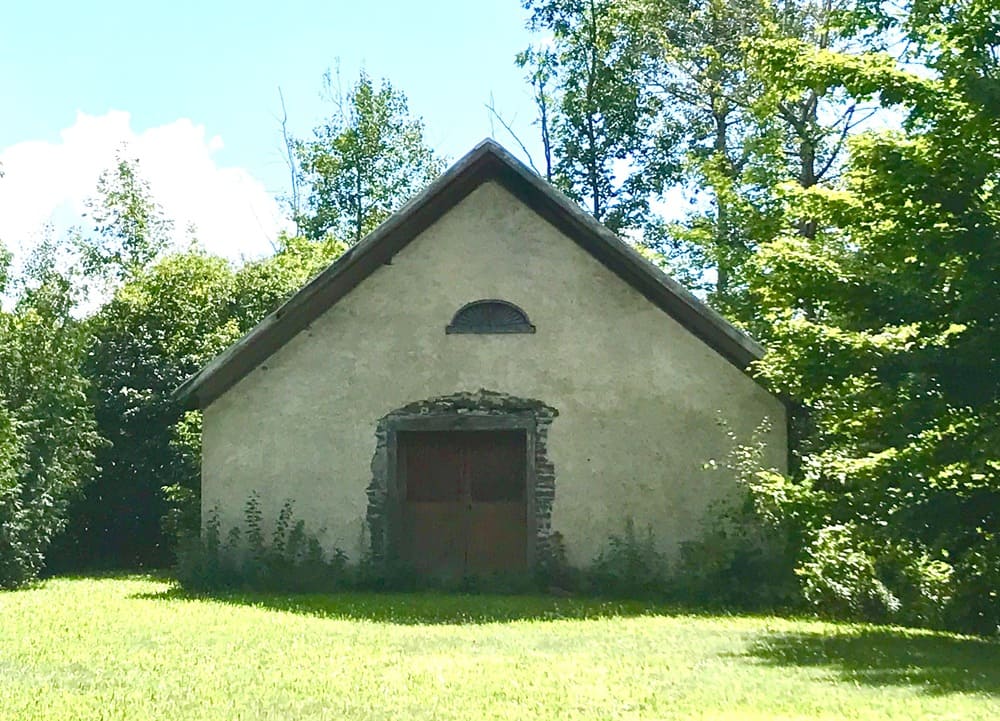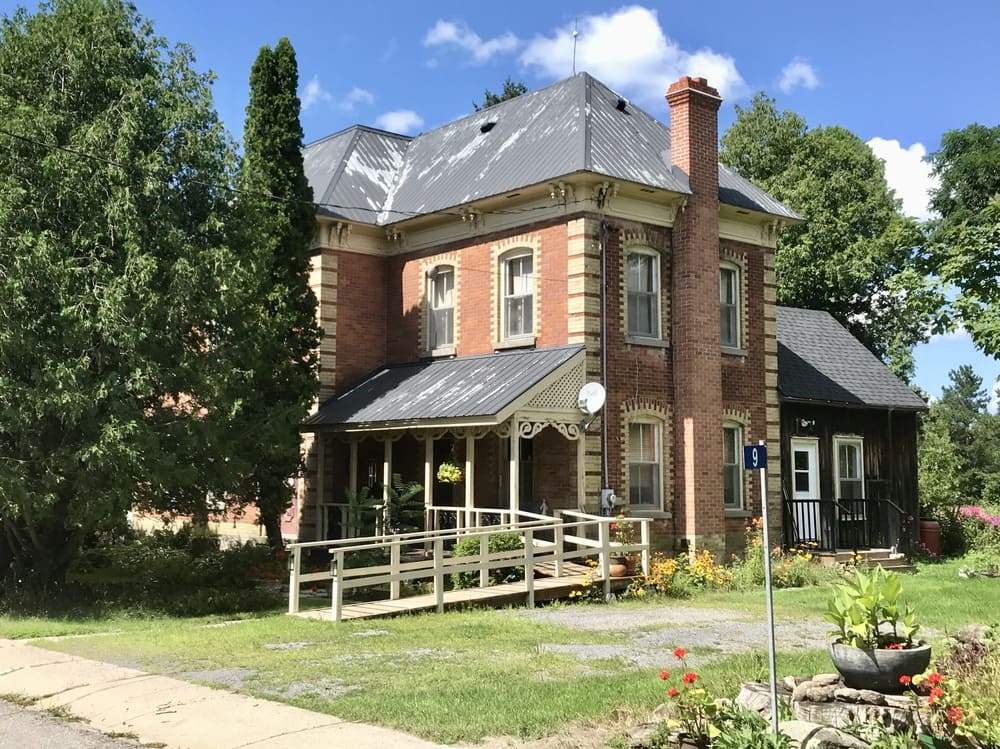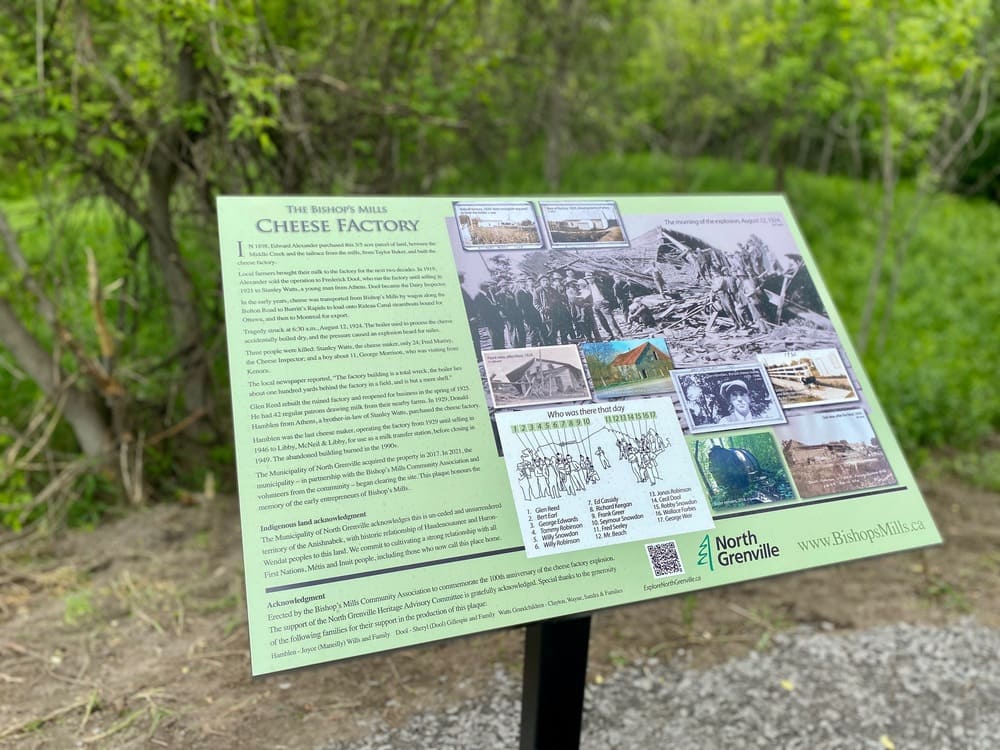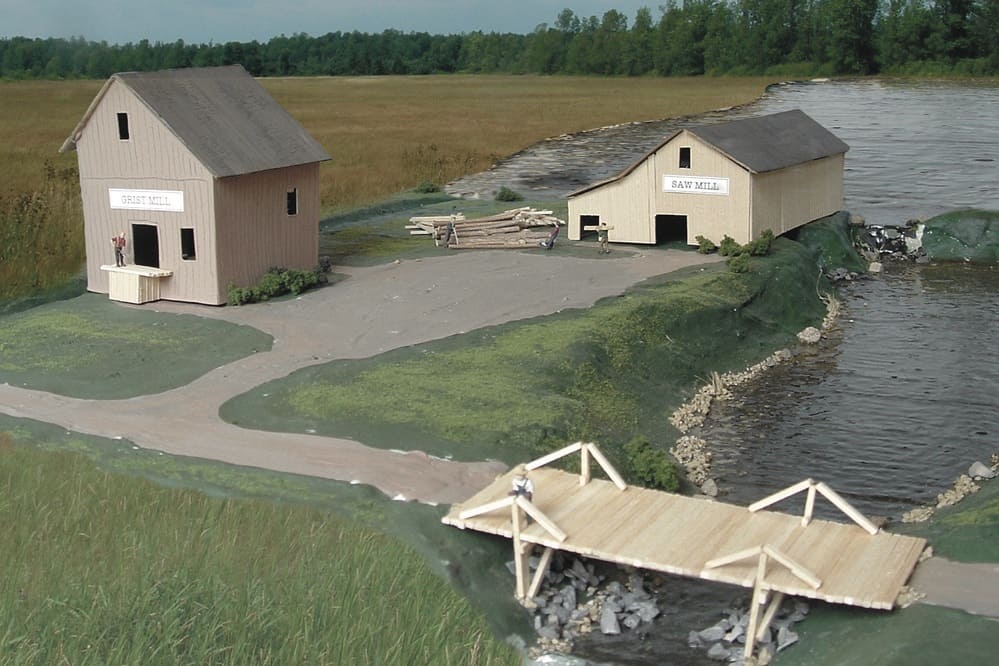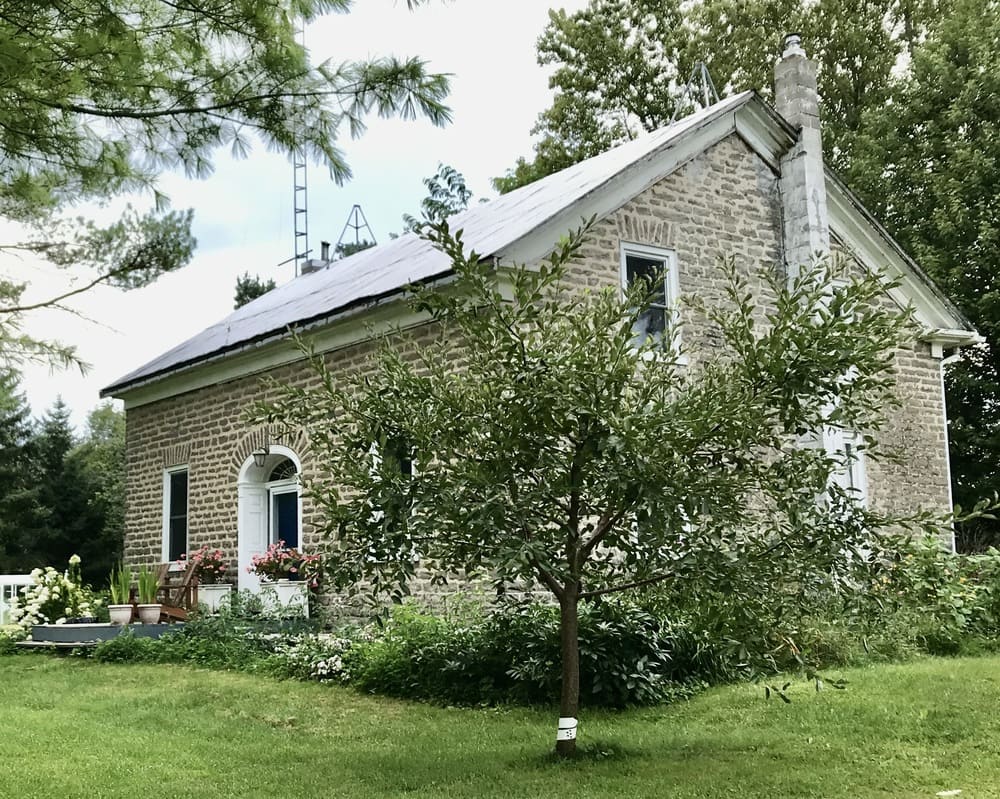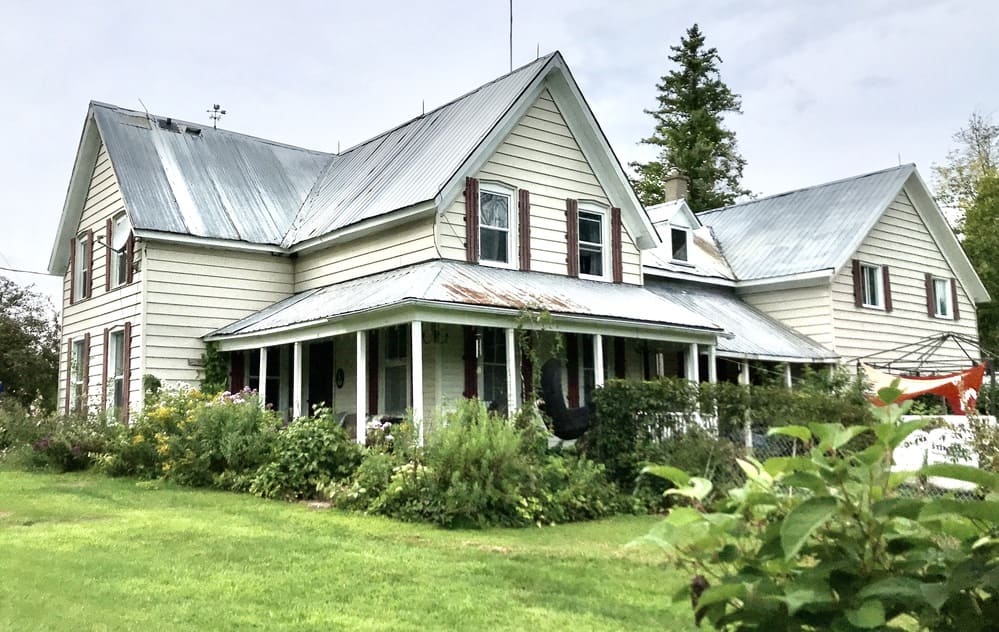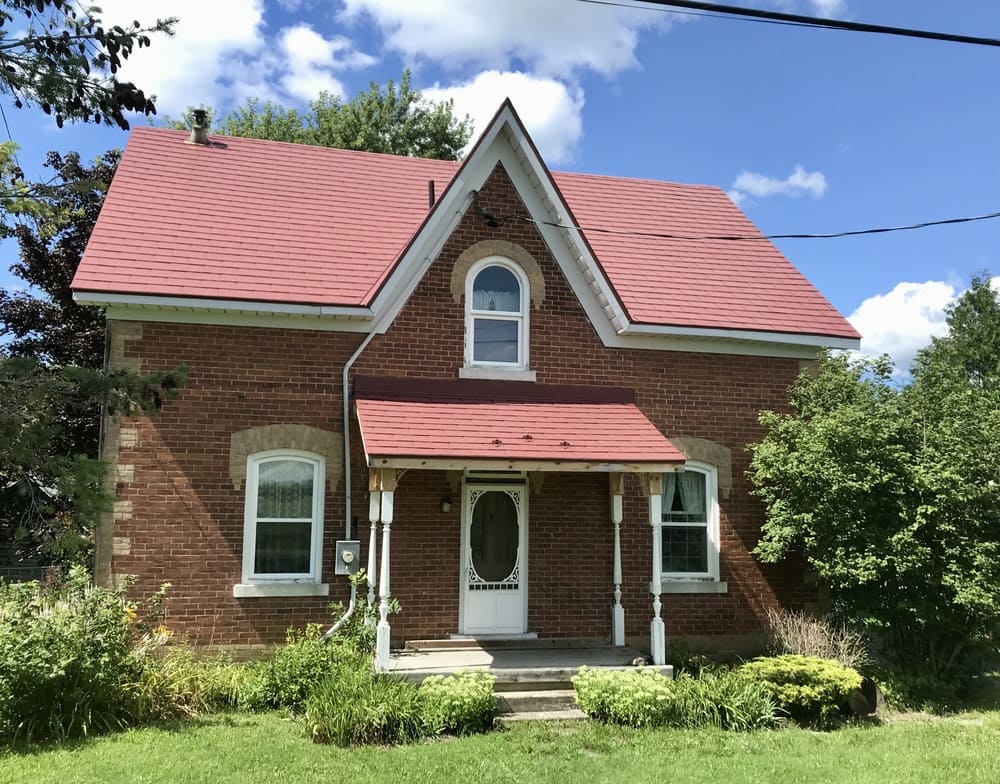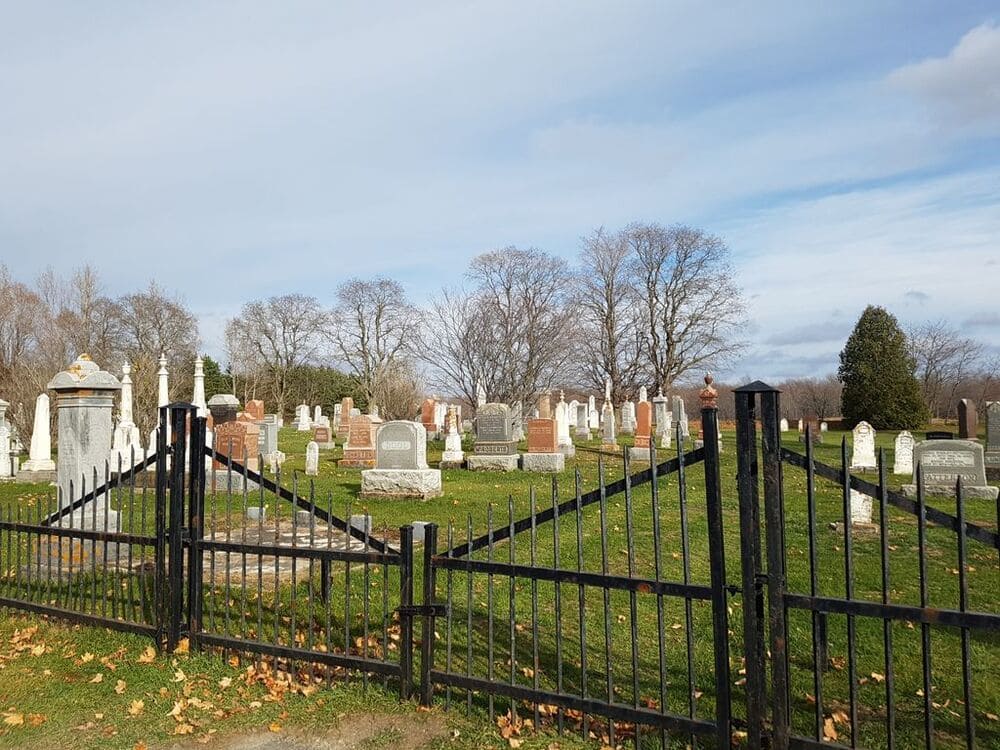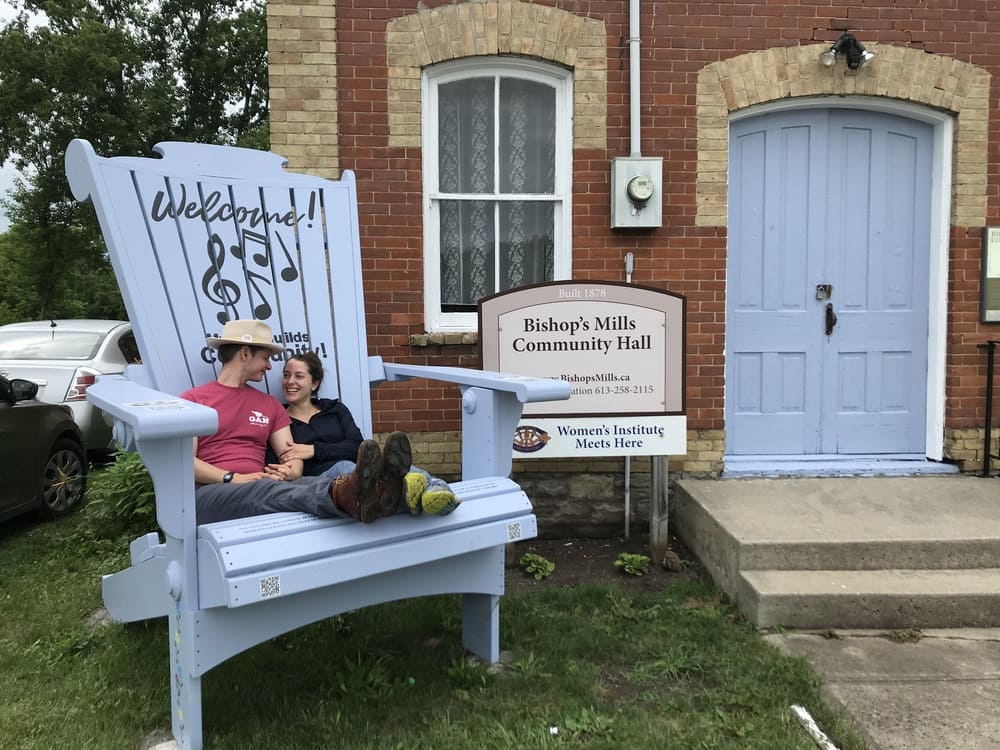
Welcome to Bishops Mills, Ontario – an historic hamlet in the municipality of North Grenville, located just 20 km south of Kemptville.
The Village had its origins around 1840 when two brothers, Chauncey and Ira Bishop, chose this location to build a sawmill and grist mill on the Middle Branch of the Rideau River. In the 19th century, the village boasted two general stores, post office, school, churches, blacksmiths, tinsmith and its own doctor.
Today, residents of this picturesque rural hamlet demonstrate pride in their heritage by actively participating in the community’s two churches, community hall, Women’s Institute and Community Association. Come and explore our heritage!
Bishops Mills Historic Walking Tour
Constructed in 1878, the Bishops Mills Community Hall was originally a meeting place for the Independent Order of Good Templars. The builder’s name – J. Wilson – and date are listed on the stone above the door.
Apparently, the Templars had good reason to establish a foothold in Bishops Mills, with at least one tavern operating in the Village. Larry Cotton, in his book Whiskey & Wickedness (2007), mentions the “tavern of Andrew Kirkland, who operated it in the late 1850's. William McLennan kept this house during the 1860's and into the early 1870's.” Also, James McLees operated a public house in Bishops Mills in the 1880's and 1890's, closing the premises about 1898.
The Temperance Movement went out of fashion at the turn of the 20th Century, and in 1926, the building was sold to three local trustees for one dollar with the provision that it be made available “for the use and purpose of the Community in General.” Renovations focused on the installation of a new wood floor and the replacement of window coal oil lamps with ceiling gas lights (later converted to electricity).
The building is an outstanding architectural example of a late 19th Century temple-fronted institutional structure with segmented arch-headed windows and openings, double front doors, a cut rough coursed stone foundation, a metal shingle roof and red brick exterior with contrasting yellow bricks.
A social and civic hub, the Hall has demonstrated remarkable resilience having served as a temporary school after fire destroyed the local school building, a polling station, and a popular venue for Sunday School concerts, wedding showers, square dances and card parties. Enduringly, it is still used today as a meeting place for the community and the local Women’s Institute. A plaque was erected on the exterior by the Heritage Advisory Committee in 2014.
Still maintained by volunteer trustees and caretakers, the Hall remains at the heart of the community, nurturing a sense of pride and identity that is as strong today as it was in 1878. The giant chair out front was donated in 2021 by the Best Adirondack Chair Company to welcome visitors to the area.
Originally sitting on land granted by the Crown in 1803 to Thomas Doyle, the current house was built in the late 1880s by a magistrate named William Connell. Around 1900, this home was a coach stop where passengers could get a meal and a room for the night. At that time the stage arrived daily with the mail from Prescott. Bishops Mills was a convenient stopover for those travelling between Prescott and Burritts Rapids.
In the early days, there was an overland route through the bush, which ran along the high ground between the St. Lawrence River to the south and the Rideau River to the north. The route, possibly following earlier trails created by Indigenous peoples, avoided the swamps and bogs, and was essential for early settlers to get around. At the time, it was referred to as the ‘Lower Rideau Road’, and is shown on a map of Oxford Township from 1836, and labeled ‘Road to Prescott’. Today, this is known as the Charleville Road and Kyle Road in Augusta. In Oxford Township (now part of North Grenville) it’s known as the Bolton Road.
The house was sold to Delbert ‘Del’ Cochrane in 1918. It was sold to Wallace Forbes in 1951 and then purchased from his widow Velma Forbes in 1975 by Victor & Linda Desroches.
Dr. Armstrong lived in this home for many years during the 1920s. The residence was in the larger section and the medical office was in the smaller section. In the early 1900s, the building housed the telegraph office operated by Molly Mack. While the location of the doors and windows may have changed over the years, the home retains many of its essential characteristics.
A list of some of the doctors who kept their offices in Bishops include Dr. Connolly from around 1890 (who was also a Sunday school teacher); Dr. Redmond, Dr. Kerfoot, Dr. Earl, Dr. Carmichael and Dr. Gordon from 1900 to 1914, and Dr. Armstrong and Dr. David in the 1920s. Eventually, they all moved their practices to larger centres, but each served the Village well in their time.
The Presbyterian congregation began worshipping in the Village c. 1865. They built a small frame church here on the present site of St. Andrew’s United Church, at 34 Main Street. This was replaced by the current stone church in 1906 under the direction of stonemason Billy Johnson, who also constructed St. Matthews in East Oxford.
The stone was drawn by horse and wagon from Deeks Quarry between the train tracks and the Scotch Line on the way to Burritt’s Rapids. The cost to build the Church in 1906 was just under $6,800. Various fundraising efforts were undertaken to pay for the new Church, including subscriptions, donations, picnics and dinners. Some of the local residents set up a fundraiser on their own: an ice cream parlour first operated by Mrs. Molly McLees and later by Gordon and Grace Greer, known as ‘Molly Mack’s Presbyterian Ice Cream Parlour’. Proceeds from the ice cream went to the building fund for the Presbyterian Church, built in 1906.
Notable features of St. Andrew’s include the bell and bell tower. The bell in the bell tower is much larger than most in the area. In 1906 the cost of the bell was $80. In the bell tower entrance there are two ropes – one for ringing the bell, and one for tolling. Also, behind the altar area is a stained-glass window, depicting the outstretched arms of Jesus. This was donated by Nathaniel and Rebecca Greer as a memorial to their two young daughters, Mary and Margaret, whom they lost to Scarlet Fever the year the Church was built.
In 1925, Church Union took place, and the Presbyterian Church became St. Andrew’s United Church, which it remains today.
Moses Waldron is widely credited as being the first storekeeper in Bishops Mills. Like the Bishop brothers, he was of Loyalist descent. Born in Lower Canada in 1827, he moved to London and engaged in the lumbering business. Historian Thadeus Levitt wrote in 1879:
“In 1860, he located at Bishops Mills, where he carries on an extensive mercantile business. He is an active member of the Canada Methodist church, and taking a deep interest in the welfare of the village, has been instrumental in obtaining postal and telegraphic facilities. He is a liberal in politics.”
When Waldron was running things, the store entrance faced Main Street, and his residence faced Mill Street. At first, the store area only occupied a narrow room the width of the building, with one counter and a wall full of shelves. This was all the space needed to sell the variety of necessities he carried. The rest of the building was his home, with wainscoting, plastered and papered walls, a sunny front parlour, Even the back summer kitchen had wallpaper. A porch ran across the front and wrapped around the side facing Mill Street as well.
He was instrumental in bringing telegraph services to the hamlet. When he died in 1879, his widow married George Ferguson and continued to run the business with his nephew Jack. The extensive mercantile business stocked nails, glass, tools, dry goods, boots, shoes, hats and gloves as well as staples such as coffee, tea, sugar, salt and tobacco. Local produce such as cheese, butter and eggs would be shipped by wagon to Oxford Station and then by rail on to Bedell and then Montreal. Remarkably, this building was the general store for the village and surrounding area until 2002. Following a brief stint as the home of the Bishops Mills Natural History Centre, it is now a private residence.
This old barn is in two parts: the section furthest from the road was originally the Methodist Church, built in 1865 and hosted an active congregation in its original location just down Mill Street towards the bridge. In 1925, upon Church Union, the congregation chose to use the Presbyterian Church and decided to sell the Methodist building with one condition: that it be used as a barn rather than a dance hall. It was purchased by Del Cochrane and drawn up the street to its current location. The part closest to the road was added later. Interesting to note that one of the lancet-arched windows from the original church was installed in the barn addition – still visible today.
1943, a fire raged through the village, consuming six buildings. The Villagers were out in the street trying to save the remaining building. Delbert (Del) Cochrane had a large straw stack just outside the barn, facing down past the school. Eye-witness and long-time resident Margaret Porter tells of how her husband and other villagers took quick action to save the straw stack from burning: “Clayton and Del Cochrane and three or four of the men went and stayed right in the straw stack, because if it had ever caught in fire the whole village would’ve gone! ‘Cause that barn and that straw stack were right in the centre of the village.”
The straw stack and the barn were saved. The church and schoolhouse across the road were not so lucky, and were consumed in the blaze. No-one was harmed and no lives were lost.
Today the site of the United Pentecostal Church, this building was once the last Bishops Mills one-room schoolhouse, constructed in 1950, in operation until rural schools were closed in 1964. In the late 1880s, a brick schoolhouse was erected here, which burnt in the fire that swept through the village in 1943. It was re-built, but burned again in 1949. In 1964, the Pentecostal congregation acquired the building and established their church there. In the 1980s, major renovations were made including a new brick façade.
The same fire destroyed the Holiness Movement church and parsonage, which sat next to the school. In a display of ‘ecumenical spirit’, members of the United Church offered the Holiness Movement congregation the use of the former church building at Bethel, a few miles away and closed since the 1920s. This offer was accepted, and the church building was moved from its location to replace the church that burnt.
When relocated, the Holiness congregation kept the dedication stone from the old building intact (Bethel M.N.C. – Methodist New Connexion), but added a new stone with their name and date the building was opened: 1943. Today, the church and original parsonage are gone, but you can see the dedication stones in front of the Pentecostal Church.
It is said that, over the years, there were 13 blacksmiths’ shops in Bishops Mills! One of them was at the main intersection in the village, at the corner of Buker Rd. and St. Lawrence St. At one time, the shop was owned by Rufus McCoy, then later run as a feed store owned by Eldon Snowdon. Although the building is no longer standing, the large round wheelwright’s stone used for forging iron wheel rims is still visible on the corner.
Built c. 1890, this house was built in phases. The forward section was built first. Later, the recessed section with the unusual triangular topped window in the peak was built. Even though the house has been renovated, this feature has been preserved.
In the 1930s, sisters Lucy and Annie McLellan lived here for many years with their other sister Minnie, a teacher. One night a neighbour girl reported to her mother that the drapes were all drawn on the main floor and the table was set with the family finery. As it turned out, the occasion was Minnie’s secret wedding to a Mr. Throop. The revelation resulted in a hamlet-wide shivaree for the young couple. The bells of the school house and churches rang out and the village children banged metal pots in the streets.
This house was built c. 1878 by Taylor Buker, a local lumberman and farmer, on land formerly owned by Elias Bishop. It was modeled after the home built by his father, Hiram Buker, which was featured in the 1879 History of Leeds and Grenville. The roofline was once highlighted by a cupola over the central section. The original chimneys have been removed. The building is constructed of common bond brick and is highlighted with contrasting yellow brick detailing around the doors, windows and the engaged quoins, and paired Italianate brackets on the eaves.
The Bukers and the Bishop families were Loyalists who left Connecticut in the 1790s for the freedom of Canada. They settled in Augusta Township about 25 km south of Bishops Mills near modern day Glenmore. The families were connected: William Bishop’s grand-daughter, Lavina, married David Buker’s grandson, Hiram.
It was Hiram Buker (1817-1895) who built a sawmill on the creek on property owned by the Bishops on the 5th concession in Augusta in 1833. Buker developed a prosperous lumbering business cutting logs from the dense bush and forest north of the swamp and turning them into lumber and shingles at his mills.
In 1847, Hiram then moved his operations to Wolford Township (Lot 17, Conc. 7). From here, he grew his enterprise to a 950-acre farm and became…“actively engaged in farming and the lumber business. His residence is considered one of the most substantial in the United Counties, and is finished with all the modern improvements.” (from Thadeus Leavitt’s The History of Leeds & Grenville, 1879)
By 1840, the two Bishop brothers, Chauncey and Ira, began to explore potential sites for their own mill operations. Heading north on the Lower Rideau Road towards Burritts Rapids, they soon crossed the Middle Branch of the Rideau and discovered the perfect spot: Lots 2 & 3, Concession 9, in Oxford Township. And Bishops Mills was born. (Source: Tales from the General Store: The Untold History of Bishops Mills.)
While Hiram’s ‘substantial’ residence in Wolford is no longer standing (destroyed by an explosion or fire rumoured to be due to a labour dispute with his mill workers…), the brick home in Bishops Mills at 9 Mill Street built by his son, Taylor Buker, is still in beautiful condition.
The plaque at this site tells the story of how, in 1898, Edward Alexander purchased this 3/5 acre parcel of land, between the Middle Creek and the tail race from the mills, from Taylor Buker, and built the cheese factory.
Local farmers brought their milk to the factory for the next two decades. In 1919, Alexander sold the operation to Frederick Dool, who ran the factory until selling in 1921 to Stanley Watts, a young man from Athens. Dool became the Dairy Inspector.
In the early years, cheese was transported from Bishops Mills by wagon along the Bolton Road to Burritts Rapids to load onto Rideau Canal steamboats bound for Ottawa, and then to Montreal for export.
Tragedy struck at 6:30 a.m., August 12, 1924. The boiler used to process the cheese accidentally boiled dry, and the pressure caused an explosion heard for miles.
Three people were killed: Stanley Watts, the cheese maker, only 24; Fred Murray, the Cheese Inspector; and a boy about 11, George Morrison, who was visiting from Kenora.
The local newspaper reported, “The factory building is a total wreck, the boiler lies about one hundred yards behind the factory in a field, and is but a mere shell.”
Glen Reed rebuilt the ruined factory, and reopened in spring 1925. He had 42 regular patrons drawing milk from their nearby farms. In 1929, Donald Hamblen from Athens, a brother-in-law of Stanley Watts, purchased the cheese factory.
Hamblen was the last cheese maker, operating the factory from 1929 until selling in 1946 to Libby, McNeil & Libby, for use as a milk transfer station, before closing in1949. The abandoned building burned in the 1990s.
The Municipality of North Grenville acquired the property in 2017. In 2021, the municipality – in partnership with the Bishops Mills Community Association and volunteers from the community – began clearing the site. This plaque was erected in 2022, to honour the memory of the early entrepreneurs of Bishops Mills.
About The Mills – and How They Worked
About 1840, two brothers, Chauncey and Ira Bishop, descendants of Loyalists from Connecticut, acquired land on the Middle Branch of the Rideau River. This land was part of Lot 2 and 3, 9th Concession of Oxford Township. Here is where they built the sawmill and gristmill that gave the Village its name.
The mills were powered by a breast wheel (see below) to make maximum use of the water available and was sufficiently large to mill planks 18 feet long that moved past a cross-cut saw blade on a carriage. Shingles were cut during low flow periods.
The Bishop brothers knew that this location on the creek would provide them with the water power necessary to run their business and start a community. They began by constructing an earthen dam (still visible today!). Depending on the time of year, the earthen dam only provided about 6 feet of head – or height – of water to power their mills. This was not uncommon in eastern Ontario where the landscape is relatively flat.
In the photo above, a scale model of the mills has been superimposed on a background to represent the vast millpond held back by the dam. The millrace (canal) that powers the gristmill on the left flows behind it and under the road. It returns to the creek downstream from the bridge.
The mills were abandoned and burned down in 1913, with their stone foundations becoming part of the adjacent roadbed. The earthen dam and millrace are still visible today.
The Breast Wheel
Because of the relatively small height or head of water available, the Bishops likely used a breast water wheel (so-named, as the water struck the wheel part-way up the wheel – as opposed to pouring over or under it…). A separate water wheel was required for each mill. The sawmill drew its water directly adjacent to the dam, while the nearby gristmill drew its water through a canal – or millrace – also still visible today.
According to Bruce Henbest, lead sawyer at Upper Canada Village, “Most mills in eastern Ontario used a variation on this kind of waterpower, and that many of the 19th century sawmills would appear very similar.” (Ed. Note: the sawmill at Upper Canada Village came from just west of Heckston, in North Grenville, about 10 miles from Bishops Mills.)


The Sawmill
Most 19th century sawmills consisted of a straight saw blade strung tight in a rectangular wooden frame, called a sash or gate. The saw sash is connected to a water wheel below it through a crank and by a wooden sweep or pitman arm (the latter taking its name from the person who – before sawmills made him obsolete – stood in a pit below a log and pulled a saw through the wood by hand to make boards).
The turning motion of the water wheel is converted to the up and down motion of the saw by the eccentric crank. Some power from the saw sash is used to turn a large gear, called a rag wheel. This in turn moves the carriage which the log rests on, pulling the log through the saw. The saw cuts into the log on its down stroke, and the log moves forward again on the up stroke. After one board is sawed, the log carriage is run back to the other end of the mill, the log moved over, and another board cut. This process is repeated until the whole log has been sawed into lumber.
Farmers in the area would draw their logs to the mill in the winter on sleds pulled by teams of horses. The Bishops would charge the farmers by the board foot (a volumetric measurement one foot by one foot by one inch) to saw the logs into boards, planks, and timbers. More often, they would cut the logs at no charge to the farmer – and keep half of the lumber to sell to those who had cash.
In times of low water, there would still be enough head to power shingle-making equipment. Made of abundant local cedar, a sawn shingle would last up to 20 years.
Working at the Mills, ca 1870s
Back in the day, everyone had a job. Local resident Osborne Dool (1926 – 2014) remembered hearing stories about his grandfather’s brother, Frank Dool, working at the mills as a boy. His job? “Piling shingles and shooting rats.” With the men working in the sawmill turning out shingles, and the gristmill grinding out sacks of flour, there would always be a place for a young boy to do the smaller – but important –jobs.
The Gristmill
A gristmill is a mill that grinds grain. Farmers would bring their grain to the Bishop mill, where the grain would be emptied into compartments. There, shaft-driven rollers or millstones, rotate against each other and crush the grain into finer particles. The customer paid a toll, or fraction of the grain he brought to the mill, in exchange for having his corn, rye, or wheat ground into meal. The final product, meal or flour, was used as feed for various farmyard animals or for household baking.

Source: Tales from the General Store: The Untold History of Bishop’s Mills.
Additional text and graphics courtesy of Old Sturbridge Village, MA www.osv.org. Used with permission.
This house was constructed c. 1850 by mill owner and village co-founder Chauncey Bishop. The house was built to overlook the creek and his milling operation. Originally, a short lane named Water Street ran in front of the house. As a prosperous businessman in the village, Chauncey was instrumental in bringing postal facilities to the community. The village Post Office was located in the rear of the stone house and stayed in the Bishop family for 25 years. Local residents can still remember when there was a slot in the back corner of the house to receive mail. The mail slot is no longer there. There is a hearth in the basement, believed to be a baker’s oven, with a fireplace directly above on the first floor.
Bishops Mills has been in the Canadian Postal Records since before Canada was a country. Early records show the first postmaster in Bishops Mills was H.A. Bishop, (believed to be Hannah Bishop, wife of Chauncey Bishop), and that she was appointed in January 1853.
Mail arrived at Bishops Mills from North Augusta once a week. In the 1850s, James Wilcox was the contractor to carry the mail by “horse or vehicle”. He was paid $40.00 for the year ending September 30, 1859. The Postmaster's salary that year was $7.63 per annum. The Postmaster’s salary was based on the Post Office’s gross revenue.
By 1875, we learn that “Mail arrived at Bishops Mills from Oxford Mills twice a week. A.W. Bishop was the contractor to carry the mail by “horse or vehicle”. He was paid $65.00 for the year ending June 30, 1875. The Post Office’s gross revenue was $93.33, out of which the Postmaster received a salary that year of $36.00 per annum.”
By 1878, Moses Waldron was storekeeper in the Village, and “operating an extensive mercantile business” out of the General Store at the corner of Main and Mill Street. On May 1st, the Post Office was moved to the store and Waldron became Postmaster until his death a year later.
The stately stone home still looks over the creek, although the mills are no longer there.
This house was built c. 1870 and served as the parsonage for the Methodist Church until 1940. The house is timber frame construction and was clad in clapboard. It was purchased by the Church from William Patton.
For many years this house belonged to Margaret Porter (c. 1910-1999). Margaret was the organist leading the St. Andrew’s United Church Choir. She would play every Sunday and organize the annual Christmas Carol Service at the church. She grew up in Bishops Mills as Margaret Keegan and attended the one-room schoolhouse at the southern edge of the village. Her parents were staunch Methodists and sang faithfully in the choir at the old Methodist Church in the village.
Built for the Presbyterian Church around 1879, this home served as the Manse until Church Union in 1925. The minister was responsible for both the Bishops Mills Church and St. Matthews in Patterson’s Corners/East Oxford. Built of triple brick walls of common bond brick with contrasting yellow brick detailing over the windows with imbedded quoins, on a stone foundation. After having been clad in aluminum siding for many years, the current owners removed it in 2005 to once again reveal this beautiful brick building.
About two km north-east of the Village is the Bishops Mills Cemetery. Here lie the remains of some of Bishops earliest pioneers, including Chauncey and Ira Bishop, and dates go back as far as 1862. The first acre of land was acquired on August 7, 1856, purchased from Thomas and Jane Alexander for the sum of Five Pounds and Ten Shillings. Additional land was purchased in 1937 and 1955. In the 1930s, a Mr. Fancet, visiting from Alberta, was instrumental in rehabilitating the cemetery, which had become neglected. Many of Bishops Mill's early pioneer families are buried here, including names such as Buker, Dool, Connell, Earl, Ferguson, Greer, Keegan, Lundy, McLellan, Robinson, Waldron and Weir.

